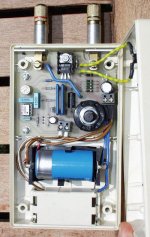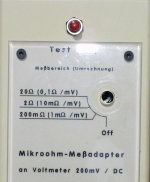Look at this: http://www.comunidadelectronicos.com/proyectos/med-res.htm
In spanish.
good bye
José Ramón
In spanish.
good bye
José Ramón
The best way to measure them is either to use a four-point system (where a known constant current is passed through the resistor, and the voltage drop is measured) or to put a bunch of them in a series string, run a voltage through the string, then measure the voltage drop across each resistor. The latter method is most suitable for matching, rather than getting an absolute value.
you can also use a Wheatstone bridge which you'll find in most high school physics labs --
since EBay is now taken up more by dealers than garage sales it is getting trickier to score a bargain on an HP3468 or HP3478 -- but good 5.5 digit meters from Fluke, Racal Dana, Keithley still abound. RLC bridges tend to be "clunky" but can be very, very acurate and comparatively inexpensive.
since EBay is now taken up more by dealers than garage sales it is getting trickier to score a bargain on an HP3468 or HP3478 -- but good 5.5 digit meters from Fluke, Racal Dana, Keithley still abound. RLC bridges tend to be "clunky" but can be very, very acurate and comparatively inexpensive.
originally posted by SY
The best way to measure them is either to use a four-point system (where a known constant current is passed through the resistor, and the voltage drop is measured)...........
Commercial 4-point resistance measuring equipment can be quite expensive.
You can DIY such a thing relatively cheap.
The following photo is taken from my DIY constant-current 4-point measuring adapter. It is used together with a conventional DVM in the 200mV DC measuring range.
3 precision resistors (the 2 lengthy blue things and the smaller black one aside), 1 FET, 2 batteries, 1 switch, 1 OP-Amp and that is it almost.
It is made according (with modified PCB) an ELEKTOR puplication.
Works fine!
If You`re interested I can look up which ELEKTOR publication it was.
Attachments
I've used a Kelvin Bridge (a Tinsley, but much older model than the one shown) for very low resistance measurement (microhms or less). Ran off a small lead-acid battery, so I guess current was fairly high compared to modern ones. 
- Status
- This old topic is closed. If you want to reopen this topic, contact a moderator using the "Report Post" button.
- Home
- Design & Build
- Parts
- How to measure resistors below 1R

